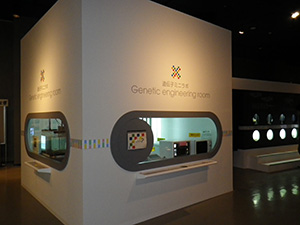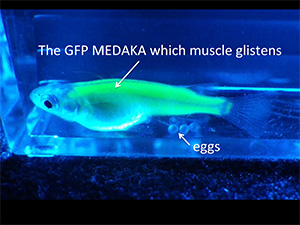Nagoya City Science Museum
TOP > Exhibition Guide > Floor Map> Genetic engineering room
Genetic engineering room

Purpose of Exhibition
The "Genetic Engineering Room" is a small room like a laboratory for genetic science. In this room are an exhibit raising genetically modified GFP medaka and a number of tools frequently used for genetic analysis, such as a thermal cycler and electrophoresis apparatus. The aim of this room is to stimulate interest in genetic science research. This permanent scientific exhibit allowing visitors to see living GFP medaka is the first such attempt in Japan. Also, since this room has actual experimental equipment, simple genetic analysis can be done here. Sometimes open genetic analysis experiments will also be performed here, so please do come see them.
Performing genetic modification experiments and raising genetically modified organisms requires facilities and operation methods that follow legal standards *. It is not allowed to carry out a genetically-modified experiment in this room, but it is equipped with facilities as a "Special Breeding Area" for genetically modified medaka and raises genetically modified GFP medaka.
*The "Law Concerning the Conservation and Sustainable Use of Biological Diversity through Regulations on the Use of Living Modified Organisms" (commonly called the Cartagena Law) was enacted in June 2003 and came into effect on February 19, 2004.


Additional Knowledge
A GFP medaka is a medaka incorporating genes for green fluorescent protein (GFP). GFP is a substance discovered (in 1962) from the Aequorea Victoria jellyfish by Dr. Osamu Shimomura, who won the Nobel Prize in Chemistry in 2008. GFP has a different mechanism for lighting up from bioluminescence substances such as luciferin in fireflies. It is a fluorescent protein that shines green when illuminated with ultraviolet or blue light, even in the absence of ATP and oxygen. The one who succeeded in incorporating the gene for this protein in other organisms was Dr.Martin Chalfie, who shared the Nobel Prize with Dr. Shimomura.
The GFP medaka exhibited in the "Genetic Engineering Room" is the "OIMA1-GFP" family. A promoter (a part of base sequence determining when and/or which kind of cells genes express in) that has only the genes expressed in the skeletal muscle cells of a medaka and GFP gene plasmids (small ring-shaped DNA chains that Escherichia coli have) are microinjected into fertilized medaka eggs. When this is done, the plasmids are taken into the medaka chromosomes. In the process of the medaka growing through cell division from the fertilized ova, when the skeletal muscle cells produce muscle protein, they produce GFP along with it. In order words, GFP is also produced in cells with skeletal muscle protein. Then, if ultraviolet light is shone on them, the GFP lights up green and you can see with your eyes the location of the skeletal muscle cells. By using this technology, you can observe and verify in the living cell which genes are functioning where and at what times as a body is formed from a fertilized egg. This technology is widely used in research into gene expression and generation, as a marker for cancer cells, etc. This too is possible because base sequence of DNA become genetic information and work in the same way in organisms around the Earth.
Cooperation:National Institute of basic biology
Article by Chieko Ozaka,curator
